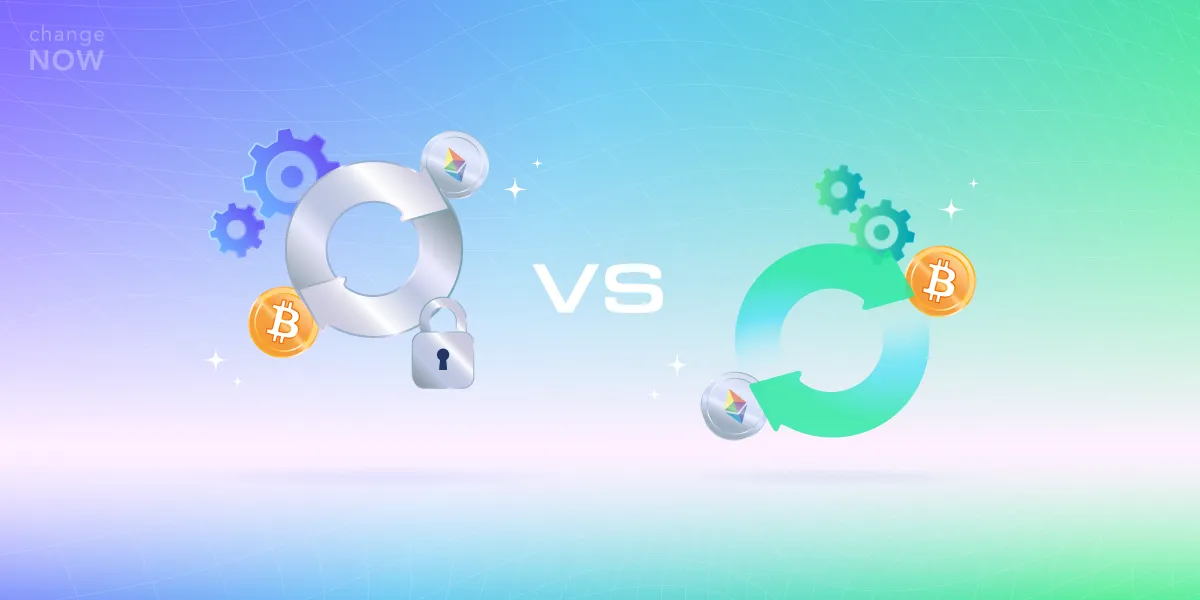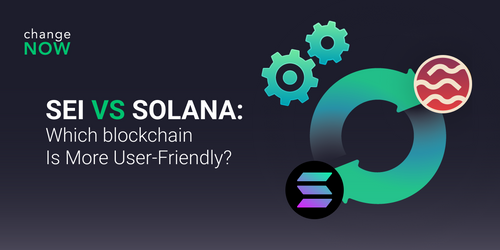Fixed Rate vs Classic Flow: Understanding the Differences
Understanding Exchange Rates
Before we delve into the details of Fixed Rate and Classic Flow, it's crucial to understand how these concepts work in the context of cryptocurrency exchanges. Exchange types play a significant role in determining how much you pay for buying or exchanging cryptocurrencies. ChangeNOW, a leading cryptocurrency exchange platform, offers two main exchange flows — Fixed and Classic (or Standard). Let's explore these options and see how they are implemented by ChangeNOW.

Fixed Rate
ChangeNOW's Fixed Rate is a pricing model that provides users with a fixed exchange rate for a specific cryptocurrency. This means that regardless of market fluctuations, you will receive the exact amount of crypto you expect. Fixed flow offers stability and transparency, as you know the precise value of your transaction before initiating it.
When you choose the Fixed flow on ChangeNOW, you lock in the exchange rate for a set amount of time. This duration allows you to complete the transaction without worrying about sudden price changes. ChangeNOW achieves this by partnering with reliable liquidity providers, ensuring the best rates on the market. Fixed Rate usually comes with a small premium, around 0.5–1%, on top of the current market rate to account for potential price swings.
Example:
In practice, you’re paying a little extra compared to the spot market, but the benefit is that the amount you’ll receive is guaranteed — no surprises along the way.
Benefits of Fixed Rate
Choosing a fixed rate option in crypto is more than simply locking a number on a screen — it’s about creating a sense of certainty in an environment that often feels unpredictable. This model of exchange offers a range of practical benefits:
Certainty From Start to Finish. The biggest benefit is simple: what you see is exactly what you get. The exchange rate is locked the moment you confirm the deal, so the amount you expect to receive doesn’t shrink because the market shifted while your transaction was in progress.
Clear and Predictable Outcomes. For anyone who needs consistency — whether it’s freelancers being paid in crypto, businesses handling payroll, or long-term investors moving funds into stablecoins — Fixed Rate makes planning easier. You’ll know the exact numbers before you click “send.”
Protection in Volatile Times. The second half of 2025 has brought sharp swings around regulatory decisions, Bitcoin ETFs, and altcoin launches. Fixed Rate gives you a kind of built-in safety net, insulating your transaction from these sudden spikes or dips.
Beginner-Friendly Experience. If you’re new to crypto exchanges, Fixed Rate is often the best starting point. There’s no pressure to “time the market,” no need to calculate potential slippage — just a straightforward, locked-in deal that makes the process less stressful.
A Safer Choice for Big Transfers. When moving larger amounts, even small price shifts can make a noticeable difference. Fixed Rate ensures that those funds land exactly where you expect them, making it a solid choice for high-value swaps.
Drawbacks of Fixed Rate
While fixed rate swaps provide security and predictability, they are not without trade-offs. Anyone considering this option should weigh the following limitations before deciding:
Rates May Be Less Competitive. Because the platform has to hedge against sudden price movements, the rate you receive in a fixed deal can sometimes be slightly less favorable than the one available through a variable exchange at that same moment. In other words, you are paying a small “premium” for the guarantee of certainty.
Limited Opportunity to Ride Market Waves. Fixed rates are designed for stability, which means they don’t allow you to benefit if the market suddenly shifts in your favor during the transaction window. For participants who enjoy following market swings and capturing the absolute best price, this model may feel restrictive.
Strict Time Windows. A locked rate comes with deadlines. Typically, there are only a couple of minutes to confirm the quote and around twenty minutes to send the deposit. If you miss these time frames, the lock expires and you may need to start the process again at a new rate. For larger transfers or during times of network congestion, this can be inconvenient.
Not Available for Every Asset. While most popular cryptocurrencies support fixed rate swaps, some lesser-known tokens or newly launched projects may only be available under variable conditions. This can limit your options if you’re dealing with niche assets.
Classic Flow: Real-Time Market Dynamics
ChangeNOW's Classic Flow offers a variable exchange rate based on real-time market conditions. When using the Classic flow option, the exchange rate is determined at the moment of the transaction, reflecting current market prices. This provides flexibility and potential access to better rates, especially for larger transactions.
With Classic Flow, you can leverage market fluctuations to maximize gains. ChangeNOW draws from a wide network of liquidity providers to offer competitive rates in real-time. By tracking trends, you can decide the optimal moment to execute your transaction.
How Slippage Works in Crypto Exchanges
Slippage is the difference between the price you see when initiating a transaction and the price at which the trade actually executes.
Key Factors That Influence Slippage
- High market volatility
- Large transaction volumes
Slippage can’t be completely avoided, but you can take steps to keep it under control:
- Using limit orders where possible, setting a maximum acceptable slippage.
- Spliting large trades into smaller transactions to reduce market impact.
- Checking liquidity and recent volatility for the trading pair before executing.
- Monitoring network conditions, especially on blockchains with variable transaction speeds and fees.
Benefits of Classic Rate
Unlike fixed swaps, classic rate exchanges follow the market in real time. This model has several strengths that appeal to participants who are comfortable with short-term uncertainty in exchange for potential gains.
Access to Competitive Rates. With Classic Flow, your transaction is executed at the current market price, drawing from a pool of liquidity across multiple sources. You get rates that reflect real-time market conditions. If prices shift in your favor while the transaction is processing, the amount you receive can end up slightly higher.
Advantageous in Rising Markets. For those confident about positive price momentum, variable exchanges can enhance returns. A rising market means your payout could end up higher than what was first quoted.
Suitable for Large Transactions. When exchanging significant volumes, even a small improvement in the rate can result in meaningful savings. Classic rate swaps can maximize this advantage if market conditions are moving in the right direction.
No Expiration Pressure. Unlike fixed rate deals that lock for only a short window, variable swaps typically don’t force the same tight deadlines. Participants have more breathing room to send funds without worrying about expiring quotes.
Drawbacks of Classic Rate
Vulnerability to Price Swings. Markets rarely stand still. If the value of an asset drops while your transfer is still in progress, the amount you receive may end up smaller than expected. For those who prioritize predictability, this uncertainty can be frustrating.
Slippage Risk. Variable swaps are especially sensitive to slippage. The quoted price can shift between the time you launch the transaction and the moment it actually settles. In periods of heavy trading, these discrepancies can become noticeable.
Difficulties With Financial Planning. People or companies who rely on clear numbers — for example, when paying invoices, salaries, or taxes — may find variable rates less convenient. Because the final sum isn’t confirmed until the deal closes, it can complicate budgeting.
Market Awareness Required. To take advantage of this type of exchange, participants often need to watch market trends more closely. Without that level of attention, it’s easy to mistime an order or settle for less favorable terms.
Fixed Rate vs Classic Rate: Final Comparison
| Feature | Fixed Rate | Classic Rate |
|---|---|---|
| Exchange Rate | Locked at confirmation, guaranteed outcome | Determined at execution, may fluctuate |
| Slippage Risk | None (rate protected) | Possible, especially in volatile markets |
| Best For | Predictable transfers, budgeting, stability | Opportunistic trades, flexible strategies |
| Time Limits | Quote valid for a short window (e.g. ~20 min) | No strict deadline for sending funds |
| Market Conditions | Safer during high volatility | Potentially better during rising markets |
| Transaction Size | Suitable for large transfers needing certainty | Can maximize gains on large trades if timed well |
How to Choose the Right Exchange Flow for You
Choosing between a fixed rate or a classic flow exchange is less about theory and more about matching the tool to your circumstances. Each approach carries its own strengths, and the right choice depends on what you value most: certainty or flexibility.
If your priority is predictability, a fixed rate exchange offers peace of mind. The outcome is locked in from the start, insulating you from sudden price swings or hidden slippage. This reliability makes it especially useful for everyday conversions, covering recurring expenses, or transferring funds during periods of heightened volatility.
The classic flow, on the other hand, appeals to those who are comfortable with movement in the markets. Because the rate adjusts in real time, there is potential to walk away with a more favorable deal — particularly when prices are trending upward or liquidity is strong. For participants who keep an eye on short-term dynamics, this path can provide extra value.
Points to Weigh Before Choosing
Size of the exchange Large transactions magnify even minor shifts in price. A fixed rate protects against unexpected losses, while a classic rate can capture additional upside if timed well.
Current market climate In quieter periods, variable pricing can be advantageous. During volatile swings, fixed rates may offer a safer shelter.
Comfort with risk Those who prefer certainty will lean toward fixed rates; those willing to accept unpredictability in search of better returns may opt for variable rates.
Exchange Purpose Budgeting for bills, salaries, or stable investments often favors fixed rates.
Outlook for 2025
With regulatory changes, new blockchain networks, and frequent price shocks shaping the landscape, many users now combine both methods. Fixed rates are used for essential transfers where accuracy is non-negotiable, while classic rates are chosen for discretionary trades that benefit from live market pricing. Having both tools at hand allows participants to adapt, rather than commit to one approach in every situation.
Make the Right Choice with ChangeNOW
Don’t miss the chance to use one of the best crypto exchange with fixed and variable rates. Benefit from stability, transparency, and potential market gains in your crypto transactions.


